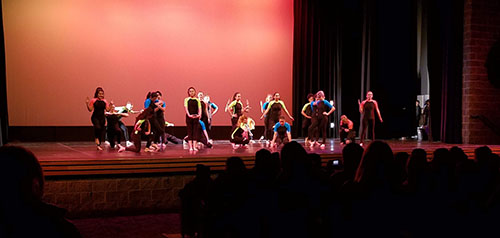Learning Confidence of Self

The young dancers moved awkwardly on the stage, their motions tentative and lacking in confidence. Unlike elementary school performances where the dancers move freely and joyfully whether or not they’re in time with the beat, these teenagers were the embodiment of self consciousness. I could see it in every motion. The arm which should extend out two more inches to really hit the mark. The hip motion which ought to move further from center of balance. The foot that needs to plant more firmly. The beginning dancers on the stage moved cautiously, more focused on matching motions to beats than on making the motions flow. It was a stark contrast to other numbers with more experienced dancers. Yet they were beautiful. All of them. The confident and self-conscious alike. They had the courage to get on the stage and show what they had learned, whether or not it was perfect. My favorites were the ones who smiled as they performed, they felt the joy of motion and music, which was far more compelling than perfection of steps.
As I watched this high school dance performance I considered what happens to children that moves us from the unselfconsciousness of childhood and into teenage years where our every action and word becomes constrained inside a box of “what will people think.” Even those teens who deliberately disrupt the norms are still reacting to the norm by defining themselves as outside of it. Then some of us, but not all, manage to break free and be who we are without reference to others, just as some of the dancers on the stage had learned to extend to the very edges of their bodies and even to project themselves so that they seemed larger than their forms could contain. For a dancer the only way to achieve this confidence of motion is practice. They must learn their bodies, their center, their edges. They must train mind and body to work in harmony. So it seems that the way to achieve confidence of self is also practice.
How does one practice self? For a writer this question might be more familiarly framed as “what is my voice?” And the same answer applies to both voice and self. You find voice by writing many things, and self by attempting many things. Over time you discover which of these things feel natural to you and which don’t. “Attempting many things” does not mean an endless round of activities. Some people do find themselves in sky diving, hiking, running, dancing, but finding our self is both smaller and larger than the activities we do. It is imitating a friends sense of humor or their accent, either consciously or unconsciously. It is wearing different styles of clothing. It is seeing how various interactions make us feel. In hundreds of tiny ways we experiment with self daily. Practicing, learning, getting better at it. And hopefully we reach a time in our lives where we have a solid sense of who we are. Then we are able to live to the edge of our skin and make our choices confidence of motion.
But if we are not there yet, we must remember that there is also beauty and courage in the beginning dancer. The one who is willing to get on stage without being perfect. The one who will be a better dancer tomorrow because they experience the stage today. Be kind to your self whatever stage you are at, because you’re beautiful.